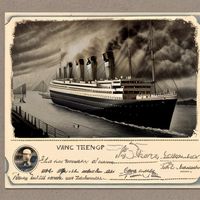A historic postcard penned by a first-class passenger aboard the Titanic is set to be auctioned later this month. The message, written in pencil by Richard William Smith, a British businessman, was addressed to Mrs. Olive Dakin in Norwich, England. The card bears a postmark of 3:45 p.m. on April 11, 1912, just three days prior to the ill-fated luxury liner's collision with an iceberg during its maiden voyage. Smith was among the nearly 1,500 souls who tragically lost their lives in the disaster. The Titanic had embarked on its journey from Southampton, with planned stops in Cherbourg, France, and Queenstown, now known as Cobh, in Ireland, before its intended arrival in New York.
The postcard, which is believed to be among Smith's final writings, reads: "Have had a fine run around to Queenstown. Just leaving for the land of stars and stripes." It concludes with a warm sign-off: "Hope you are all quite well at home. Kindest regards, R.W.S." Andrew Aldridge, the managing director of Henry Aldridge & Son, a UK-based auction house specializing in Titanic memorabilia, is handling the sale of this artifact. He revealed that Smith, a tea broker with various business interests in the United States, had been traveling on the Titanic with a family friend, Mrs. Nicholls. "She was only going a quarter of the way as she was getting off in Queenstown, so he must have asked her to post the card," Aldridge explained. "The Titanic had just stopped in Queenstown to take on additional passengers—little did anyone onboard know what was on the horizon just 80 hours or so into the future," he added. "This is a very powerful and poignant object because it represents one of the last things that Mr. Smith wrote, first and foremost."
Aldridge noted that postcards from the Titanic are "extremely rare, quite naturally," but what makes this one even more extraordinary is that it is postmarked Cork, a city located approximately 13 miles away from Queenstown. The postcard is anticipated to garner up to £10,000 ($12,900) when it is offered for sale as part of a broader "Titanic, White Star and Transport Memorabilia" auction on November 16. The auction house, situated in Devizes, southwest England, conducts two Titanic auctions annually. At its most recent auction in April, it sold a watch that once belonged to the wealthiest passenger on the Titanic for ten times its estimated value. The gold watch worn by John Jacob Astor IV, a member of the affluent Astor family, was sold for £1.175 million ($1.51 million)—a record for Titanic memorabilia, according to the auction house. Initially, it had been expected to sell for between £100,000 and £150,000 ($129,000-$193,000).
The story of the Titanic is one of the most enduring tragedies in maritime history. The postcard, a small yet significant piece of that history, offers a glimpse into the lives of those on board and the unsuspecting nature of their final moments. Richard William Smith's message, written with the optimism and excitement of a transatlantic journey, takes on a haunting significance in retrospect, knowing the fate that awaited the Titanic and its passengers.
The postcard's journey from Queenstown to Norwich is a testament to the global connections of the early 20th century. It traversed the same waters that the Titanic would soon navigate, carrying with it the hopes and dreams of a man who was unaware of the impending disaster. The postcard's survival, against all odds, serves as a tangible link to a bygone era, a reminder of the human stories that are often overshadowed by the grand narrative of the Titanic's sinking.
The rarity of such artifacts is not just due to their historical significance but also because of the circumstances under which they were created. The Titanic's sinking was a sudden and catastrophic event, leaving little time for the creation of lasting mementos. The fact that this postcard was posted just days before the disaster adds to its value, making it a unique piece of history that captures a moment in time that would soon be lost forever.
The auction of the postcard is expected to draw interest from collectors and historians alike, as it represents not only a piece of the Titanic's story but also a personal connection to one of its passengers. The message's content, with its reference to the "land of stars and stripes," speaks to the aspirations and ambitions of those who embarked on the journey, seeking new opportunities and a brighter future in America.
The postcard's postmark from Cork, rather than Queenstown, adds an additional layer of intrigue to the story. It suggests a detour or delay in the postcard's journey, a small detail that might have been insignificant at the time but now serves as a fascinating piece of the puzzle that is the Titanic's legacy. The postcard's path from Ireland to England, and its eventual sale, is a testament to the enduring fascination with the Titanic and the stories of those who sailed on her.
As the postcard goes up for auction, it stands as a silent witness to a pivotal moment in history. It is a reminder of the fragility of human life and the power of the sea, as well as a tribute to the memory of those who perished on the Titanic. The postcard's sale will not only provide a financial transaction but also a chance for a new owner to hold a piece of history in their hands, to feel the weight of the past, and to remember the lives that were forever changed by the Titanic's tragic voyage.

By Michael Brown/Apr 27, 2025

By Sophia Lewis/Apr 27, 2025

By Noah Bell/Apr 27, 2025

By Daniel Scott/Apr 27, 2025

By James Moore/Apr 27, 2025

By Megan Clark/Apr 27, 2025

By Samuel Cooper/Apr 27, 2025

By Emily Johnson/Apr 27, 2025

By Lily Simpson/Apr 27, 2025

By Emily Johnson/Dec 22, 2024

By Christopher Harris/Dec 22, 2024

By Joshua Howard/Dec 22, 2024

By Victoria Gonzalez/Dec 22, 2024

By Thomas Roberts/Dec 22, 2024

By Benjamin Evans/Dec 22, 2024